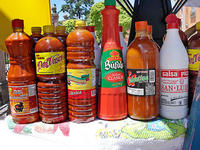-
FDA to require imported food to be inspected at the source

Each year about forty-eight million Americans get sick, some 128,000 are hospitalized, and about 3,000 dies from foodborne illnesses. Companies importing food into the United States will be held to higher safety and health standards if new proposed rules by the Food and Drug Administration (FDA) are passed. Under the proposal, the FDA would require importers to inspect food abroad before the food reaches American ports.
-
-
Crop pests spread as Earth warms, threatening global food security
Currently 10-16percent of global crop production is lost to pests. Losses of major crops to fungi, and fungi-like microorganisms, amount to enough to feed nearly 9 percent of today’s global population. These figures will increase further as global temperatures continue to rise, and a new study shows that global warming is resulting in the spread of crop pests toward the North and South Poles at a rate of nearly three km a year.
-
-
Tracking antibiotic-resistant strains of Salmonella from farm to fork

Every year in the United States, the various strains of Salmonella together are responsible for an estimated one million illnesses, 20,000 hospitalizations, and 400 deaths at an economic cost exceeding $3 billion. Salmonella Typhimurium accounts for at least 15 percent of clinically reported salmonellosis infections in humans nationally. The number of antibiotic-resistant isolates identified in humans is increasing steadily, suggesting that the spread of antibiotic-resistant strains is a major threat to public health.
-
-
Aquifer supplying a third of U.S. irrigated groundwater depleting quickly: study
The High Plains Aquifer of Kansas — also called the Ogallala Aquifer — supplies 30 percent of the U.S. irrigated groundwater. New study finds that if current irrigation trends continue, 69 percent of the groundwater stored in the High Plains Aquifer will be depleted in fifty years.
-
-
Nanoparticles in food pose health risks
Nanomaterials are increasingly used in water treatment, food packaging, pesticides, cosmetics, and other areas. There is a growing concern that these particles could pose a potential health risk to humans and the environment. In a new study, researchers have developed a reliable method for detecting silver nanoparticles in foods.
-
-
Heat waves to become more frequent, severe

Climate change is set to trigger more frequent and severe heat waves in the next thirty years regardless of the amount of carbon dioxide (CO2) we emit into the atmosphere, a new study has shown. In the first half of the twenty-first century, these projections will occur regardless of the amount of CO2 emitted into the atmosphere. After then, the rise in frequency of extreme heat waves becomes dependent on the emission scenario adopted.
-
-
The U.S. Food Emergency Response Network (FERN) tries to keep food safe
The U.S. Food Emergency Response Network (FERN) has 172 laboratories, including 39 federal, 113 state, and 17 local labs across the states and Puerto Rico. Randy Layton, FERN director, discussed the agency’s work in a July meeting of the International Association for Food Protection (IAFP).
-
-
Climate change was proximate, not primary, cause of 2012 Great Plains drought: study

From May to July 2012, the Great Plains region of the western United States faced a powerful and unpredicted drought. Following seven months of normal rainfall, the drought was one of the largest deviations from seasonal precipitation rates seen in the region since observations began in 1895. Researches find that the drought fell within the bounds of natural atmospheric variability. The strength of the drought, they suggest, was a consequence of the multiple complex nonlinear systems that make up the climate system and did not critically depend on the existence of a strong external forcing.
-
-
Imported food: Shifting from catching problems at the border to preventing them at the source
The Association of Food and Drug officials (AFDO) has published its guidance document for improving imported food safety. The document, entitled “Issues and Concerns with Imported Foods,” was released ahead of the U.S Food and Drug Administration’s (FDA) release of two rules on the same issue. The FDA aims to shift from a regulatory system that focuses on catching problems at the border and into a prevention system to correct issues before they reach the American border.
-
-
Climate change threatens world food security
The last few decades have witnessed a substantial decline in the number of hungry people worldwide. Since 2007, however, progress has slowed and world food supply and demand have been precariously balanced — climate change threatens to tip this balance, most dramatically in the poorer areas of the world.
-
-
Lawmakers criticize FDA, CDC for Cyclospora outbreak foot-dragging
Lawmakers want to know why it has taken so long for food-safety authorities to respond to the cyclospora outbreak which, so far, has sickened at least 418 people in sixteen states. They also want to know why the FDA and CDC have been tight-lipped about the specific products carrying the parasite — health authorities in Nebraska and Iowa have pointed to bagged salad containing romaine and iceberg lettuce as well as carrots and cabbage as the source – and who is the manufacturer of the contaminated products.
-
-
University of Minnesota in new food-safety partnerships with China
The National Center for Food Protection and Defense (NCFPD), a DHS center which has been housed at the College of Veterinary Medicine of the University of Minnesota since 2004, and the Chinese Academy of Inspection and Quarantine (CAIQ) have signed a memorandum of understanding on food safety, protection, and defense issues. Both organizations will work to prevent and combat intentional contamination of the food supply for either economic or terroristic reasons.
-
-
Well water contaminants highest near natural gas drilling: study
A new study of 100 private water wells in and near the Barnett Shale showed elevated levels of potential contaminants such as arsenic and selenium closest to natural gas extraction sites. Researchers believe the increased presence of metals could be due to a variety of factors including: industrial accidents such as faulty gas well casings; mechanical vibrations from natural gas drilling activity disturbing particles in neglected water well equipment; or the lowering of water tables through drought or the removal of water used for the hydraulic fracturing process. Any of these scenarios could release dangerous compounds into shallow groundwater.
-
-
North Carolina’s biothreat warning system receives funding
The North Carolina Bio-Preparedness Collaborative (NCB-Prepared), a project to develop an early warning system to detect biothreats, has received $3 million in funding. The goal of NCB-Prepared project is to develop a statewide system that can detect and alert health officials and first responders within hours of an outbreak indicating a bioterror attack, contagious disease or illness, food-borne illness, and other biothreats.
-
-
The hidden dangers of south-of-the-border hot sauce

In the last decade, the U.S Food and Drug Administration (FDA) issued several warnings about and recalls of imported food products that exceed federal standards for lead. Products containing chili peppers and salt, such as Mexican-style candies, were often suspected as sources of lead contamination. Researchers now find elevated lead levels in some hot sauces imported from Mexico. The researchers urge USDA and the FDA to develop enforceable screening standards for hot sauce.
-
- All
- Regional
- Water
- Biometrics
- Borders/Immig
- Business
- Cybersecurity
- Detection
- Disasters
- Government
- Infrastructure
- International
- Public health
- Public Safety
- Communication interoperabillity
- Emergency services
- Emergency medical services
- Fire
- First response
- IEDs
- Law Enforcement
- Law Enforcement Technology
- Military technology
- Nonlethal weapons
- Nuclear weapons
- Personal protection equipment
- Police
- Notification /alert systems
- Situational awareness
- Weapons systems
- Sci-Tech
- Sector Reports
- Surveillance
- Transportation
Advertising & Marketing: advertise@newswirepubs.com
Editorial: editor@newswirepubs.com
General: info@newswirepubs.com
2010-2011 © News Wire Publications, LLC News Wire Publications, LLC
220 Old Country Road | Suite 200 | Mineola | New York | 11501
Permissions and Policies
Editorial: editor@newswirepubs.com
General: info@newswirepubs.com
2010-2011 © News Wire Publications, LLC News Wire Publications, LLC
220 Old Country Road | Suite 200 | Mineola | New York | 11501
Permissions and Policies
